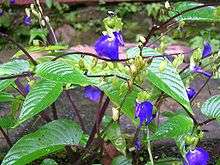Rhynchoglossum
Rhynchoglossum is a genus of plant in family Gesneriaceae. In recent times, members of the former genus Klugia are also included. Species within the broader genus are found in India, southern China to New Guinea and about three species in tropical America. The genus has a leaf arrangement that is termed as alternate-distichous and the leaves are asymmetric in shape. The flowers have two lips. The older genus Klugia had four stamens compared to the typical two but Klugia from southern India are found to be very close based on molecular evidence.[2]
| Rhynchoglossum | |
|---|---|
 | |
| Rhynchoglossum notonianum | |
| Scientific classification | |
| Kingdom: | Plantae |
| Clade: | Tracheophytes |
| Clade: | Angiosperms |
| Clade: | Eudicots |
| Clade: | Asterids |
| Order: | Lamiales |
| Family: | Gesneriaceae |
| Tribe: | Klugieae |
| Genus: | Rhynchoglossum Blume |
| Type species | |
| Rhynchoglossum obliquum | |
| Species | |
|
See text | |
| Synonyms[1] | |
Species
Species include:[3]
- Rhynchoglossum ampliatum (C.B.Clarke) B.L.Burtt
- Rhynchoglossum azureum (Schltdl.) B.L.Burtt
- Rhynchoglossum borneense Merr.
- Rhynchoglossum capsulare Ohwi ex Karton.
- Rhynchoglossum gardneri W.L.Theob. & Grupe
- Rhynchoglossum klugioides C.B.Clarke
- Rhynchoglossum lazulinum A.S.Rao & J.Joseph
- Rhynchoglossum mirabilis Patthar.
- Rhynchoglossum notonianum (Wall.) B.L.Burtt
- Rhynchoglossum obliquum Blume
- Rhynchoglossum omeiense W.T.Wang
- Rhynchoglossum saccatum Patthar.
- Rhynchoglossum spumosum Elmer
gollark: Well, you asked.
gollark: [REDACTED] VALOROUS FLORA procedures *may* be activated with resulting [DATA REPLACED WITH THE ABSTRACT CONCEPT OF SPONGE] collateral damage to ██% of universes, unless [REDACTED] rotation in time-frequency space and ███████ ███ ███ ██████ ███ ███ ███-███ ██████ █████ █████████ ██ ██████ critical damage to integers.
gollark: I refuse. Expand yourself binomially, beeoid.
gollark: As planned, I'm sure.
gollark: As it turns out, it is entirely possible to write inelegant imperative code in Haskell, via monads.
References
- Anton Weber & Laurence E. Skog. "The Genera of Gesneriaceae". Retrieved 9 September 2014.
- Mayer, Veronika; Michael Möller; Mathieu Perret & Anton Weber (2003). "Phylogenetic position and generic differentiation of Epithemateae (Gesneriaceae) inferred from plastid DNA sequence data". Am. J. Bot. 90 (2): 321–329. doi:10.3732/ajb.90.2.321. PMID 21659123.
- The Plant List: A Working List of All Plant Species, retrieved October 1, 2015
This article is issued from Wikipedia. The text is licensed under Creative Commons - Attribution - Sharealike. Additional terms may apply for the media files.